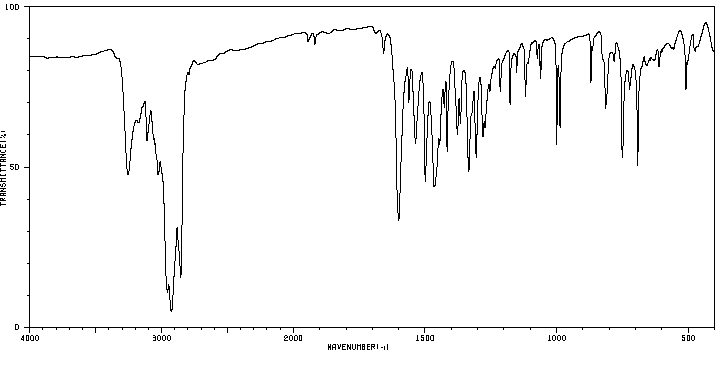N-[(4-吡啶基)甲基]苯胺 | 3034-32-0
中文名称
N-[(4-吡啶基)甲基]苯胺
中文别名
——
英文名称
N-((pyridin-4-yl)methyl)benzenamine
英文别名
N-(pyridin-4-ylmethyl)aniline;4-Anilinomethyl-pyridin
CAS
3034-32-0
化学式
C12H12N2
mdl
MFCD03725053
分子量
184.241
InChiKey
IRJVUOQNBSTXGA-UHFFFAOYSA-N
BEILSTEIN
——
EINECS
——
-
物化性质
-
计算性质
-
ADMET
-
安全信息
-
SDS
-
制备方法与用途
-
上下游信息
-
文献信息
-
表征谱图
-
同类化合物
-
相关功能分类
-
相关结构分类
物化性质
-
溶解度:>27.6 [ug/mL]
计算性质
-
辛醇/水分配系数(LogP):2.3
-
重原子数:14
-
可旋转键数:3
-
环数:2.0
-
sp3杂化的碳原子比例:0.083
-
拓扑面积:24.9
-
氢给体数:1
-
氢受体数:2
上下游信息
-
上游原料
中文名称 英文名称 CAS号 化学式 分子量 —— Thioisonicotinanilid 17332-41-1 C12H10N2S 214.291
反应信息
-
作为反应物:参考文献:名称:超越开关:用分隔的分子机器使粒子能量上坡摘要:在这里,我们将行为的化学(共价)、物理(热力学)和统计(种群分布)描述与两种新型简单分子机器(轮烷的线程)执行运输布朗底物(轮烷)任务的方式相关联。大环)在两个可区分的结合位点之间。第一个机器-基材集合是 [2] 轮烷,它通过一种机制起作用,该机制本质上使其不可逆地改变大环的平均位置。这与作为可逆分子开关的经典刺激响应分子穿梭的行为形成对比。第二个系统是一个分隔的分子机器,它能够利用光子通过烯烃光异构化提供的能量将其底物能量向上泵送。重置这个分隔的分子机器并不会撤消它已经执行的工作或执行的任务,这是与简单分子开关的显着差异和我们认为“棘轮”的特征(参见方案 8)。棘轮机制允许 [2] 轮烷执行为历史思想机器、Smoluchowski 的陷门和麦克斯韦的压力恶魔设想的传输功能,尽管是通过不相关的机制并使用能量输入。我们在分子水平上以机械术语定义和举例说明术语“棘轮”和“擒纵”,并概述构成两态DOI:10.1021/ja057664z
-
作为产物:描述:参考文献:名称:Koenig et al., Chemische Berichte, 1954, vol. 87, p. 825,834摘要:DOI:
文献信息
-
Efficient One-Pot Reductive Aminations of Carbonyl Compounds with Aquivion-Fe as a Recyclable Catalyst and Sodium Borohydride作者:Veronica Airoldi、Oreste Piccolo、Gabriella Roda、Rebecca Appiani、Francesco Bavo、Riccardo Tassini、Stefano Paganelli、Sebastiano Arnoldi、Marco Pallavicini、Cristiano BolchiDOI:10.1002/ejoc.201901614日期:2020.1.16Aldehydes and ketones were reductively aminated by a one‐pot procedure using a recyclable iron‐based Lewis catalyst, Aquivion‐Fe, to promote imine formation, and NaBH4 as reductant in cyclopentyl methyl ether and methanol. The developed protocol was successfully applied to the preparation of Cinacalcet, an important active pharmaceutical ingredient.
-
Design, synthesis and biological evaluation of GPR55 agonists作者:Lara Fakhouri、Christopher D. Cook、Mohammed H. Al-Huniti、Linda M. Console-Bram、Dow P. Hurst、Michael B.S. Spano、Daniel J. Nasrallah、Marc G. Caron、Larry S. Barak、Patricia H. Reggio、Mary E. Abood、Mitchell P. CroattDOI:10.1016/j.bmc.2017.06.016日期:2017.8consisted of coupling a variety of p-aminophenyl sulfonamides to isothiocyanates to form acylthioureas. For the synthesis of a known naphthyl ethyl alcohol motif, route modification led to a shorter and more efficient process. The 22 analogues were analyzed for their ability to serve as agonists at GPR55 and valuable information for both ends of the molecule was ascertained.
-
[EN] PYRROLO[2,3-B]PYRIDINE CDK9 KINASE INHIBITORS<br/>[FR] INHIBITEURS DE PYRROLO[2,3-B]PYRIDINE CDK9 KINASE申请人:ABBVIE INC公开号:WO2014139328A1公开(公告)日:2014-09-18Disclosed are compounds of Formula (IIa), wherein R1, R2, R3A, R3B, R3C, R3D, R3E, and R4 are as defined in the specification, and pharmaceutically acceptable salts thereof. The compounds may be used as agents in the treatment of diseases, including cancer. Also provided are pharmaceutical compositions comprising one or more compounds of Formula (IIa).公开的是Formula (IIa)的化合物,其中R1、R2、R3A、R3B、R3C、R3D、R3E和R4如规范中所定义,并且其药用盐。这些化合物可用作治疗疾病,包括癌症的药物。还提供了包含一个或多个Formula (IIa)化合物的药物组合物。
-
A Biphasic Medium Slows Down the Transfer Hydrogenation and Allows a Selective Catalytic Deuterium Labeling of Amines from Imines Mediated by a Ru−H/D<sup>+</sup>Exchange in D<sub>2</sub>O作者:Margarita Ruiz‐Castañeda、M. Carmen Carrión、Lucía Santos、Blanca R. Manzano、Gustavo Espino、Félix A. JalónDOI:10.1002/cctc.201801343日期:2018.12.7The transfer hydrogenation (TH) of several aldimines has been studied using [RuCl(p‐cymene)(dmbpy)]BF4, 1, (dmbpy=4,4′‐dimethyl‐2,2′‐bipyridine) as a precatalyst. Both neat water and a biphasic water/toluene mixture (w/t) have been successfully used as solvents. In the w/t medium the corresponding precursors, amine and aldehyde, were also used as substrates for a transfer hydrogenative reductive amination几个醛亚胺的转移氢化(TH)已使用将[RuCl(研究p -cymene)(dmbpy)] BF 4,1,(dmbpy = 4,4'-二甲基-2,2'-联吡啶)作为前段催化剂。纯水和水/甲苯两相混合物(重量/吨)均已成功用作溶剂。在w / t介质中,相应的前体胺和醛也用作转移氢化还原胺化的底物。所得烷基化胺的选择性氘标记是这项工作的主要目标。使用D 2 O时,胺中的D含量可以忽略不计,但D 2中的D掺入量很高O /甲苯。根据计算,这是由于氢化物转移的相对速率和RuH / D +交换的相对速率的影响。随着底物浓度降低,氢化物转移速率降低,氘的掺入量随时间增加。进行的可回收性分析反映了pH在TH对亚胺或亚胺水解产生的醛的亚胺或醛的选择性中的重要性。
-
Unmodified Fe3O4 nanostructure promoted with external magnetic field: safe, magnetically recoverable, and efficient nanocatalyst for N- and C-alkylation reactions in green conditions作者:Ezzat Rafiee、Mohammad Joshaghani、Parvaneh Ghaderi-Shekhi AbadiDOI:10.1007/s11164-017-3243-6日期:2018.4high catalytic activity and stability in N- and C-alkylation reactions. A diverse range of N- and C-alkylation products were obtained in moderate to high yield under green and mild conditions in air. Also the N- and C-alkylation products can be obtained with different selectivity and yield by exposure reactions with EMF. Results of alkylation reactions showed that the presence of Fe(II) and Fe(III)过渡金属化合物已作为有机反应的合适催化剂出现。磁性化合物如柔软的路易斯酸可用作有机反应的催化剂。在该报告中,在没有任何保护剂的外部磁场(EMF)下,从Fe 2+和Fe 3+盐获得了Fe 3 O 4纳米结构。X射线光电子能谱,扫描电子显微镜和能量色散X射线能谱工具用于表征这些磁性化合物。二维(二维,它在二维中显示纳米尺寸,纳米棒结构)Fe 3 O 4该化合物在N和C烷基化反应中显示出高催化活性和稳定性。在绿色和温和的条件下,在空气中以中等至高收率获得了各种N-和C-烷基化产物。通过与EMF的暴露反应,也可以以不同的选择性和产率获得N-和C-烷基化产物。烷基化反应的结果表明,磁性催化剂表面(磁性化合物的相结构)上存在Fe(II)和Fe(III)物种是非常廉价的活性位点所必需的。而且,磁性催化剂的形态对其催化性能有影响。反应后,使用外部磁体可以轻松实现催化剂/产物的分离,并且可以回收超过95%的催化剂。
表征谱图
-
氢谱1HNMR
-
质谱MS
-
碳谱13CNMR
-
红外IR
-
拉曼Raman
-
峰位数据
-
峰位匹配
-
表征信息
同类化合物
(乙腈)二氯镍(II)
(R)-(-)-α-甲基组胺二氢溴化物
(N-(2-甲基丙-2-烯-1-基)乙烷-1,2-二胺)
(4-(苄氧基)-2-(哌啶-1-基)吡啶咪丁-5-基)硼酸
(11-巯基十一烷基)-,,-三甲基溴化铵
鼠立死
鹿花菌素
鲸蜡醇硫酸酯DEA盐
鲸蜡硬脂基二甲基氯化铵
鲸蜡基胺氢氟酸盐
鲸蜡基二甲胺盐酸盐
高苯丙氨醇
高箱鲀毒素
高氯酸5-(二甲氨基)-1-({(E)-[4-(二甲氨基)苯基]甲亚基}氨基)-2-甲基吡啶正离子
高氯酸2-氯-1-({(E)-[4-(二甲氨基)苯基]甲亚基}氨基)-6-甲基吡啶正离子
高氯酸2-(丙烯酰基氧基)-N,N,N-三甲基乙铵
马诺地尔
马来酸氢十八烷酯
马来酸噻吗洛尔EP杂质C
马来酸噻吗洛尔
马来酸倍他司汀
顺式环己烷-1,3-二胺盐酸盐
顺式氯化锆二乙腈
顺式吡咯烷-3,4-二醇盐酸盐
顺式双(3-甲氧基丙腈)二氯铂(II)
顺式3,4-二氟吡咯烷盐酸盐
顺式1-甲基环丙烷1,2-二腈
顺式-二氯-反式-二乙酸-氨-环己胺合铂
顺式-二抗坏血酸(外消旋-1,2-二氨基环己烷)铂(II)水合物
顺式-N,2-二甲基环己胺
顺式-4-甲氧基-环己胺盐酸盐
顺式-4-环己烯-1.2-二胺
顺式-4-氨基-2,2,2-三氟乙酸环己酯
顺式-3-氨基环丁烷甲腈盐酸盐
顺式-2-羟基甲基-1-甲基-1-环己胺
顺式-2-甲基环己胺
顺式-2-(苯基氨基)环己醇
顺式-2-(苯基氨基)环己醇
顺式-2-(氨基甲基)-1-苯基环丙烷羧酸盐酸盐
顺式-1,3-二氨基环戊烷
顺式-1,2-环戊烷二胺二盐酸盐
顺式-1,2-环戊烷二胺
顺式-1,2-环丁腈
顺式-1,2-双氨甲基环己烷
顺式--N,N'-二甲基-1,2-环己二胺
顺式-(R,S)-1,2-二氨基环己烷铂硫酸盐
顺式-(2-氨基-环戊基)-甲醇
顺-2-戊烯腈
顺-1,3-环己烷二胺
顺-1,3-双(氨甲基)环己烷







